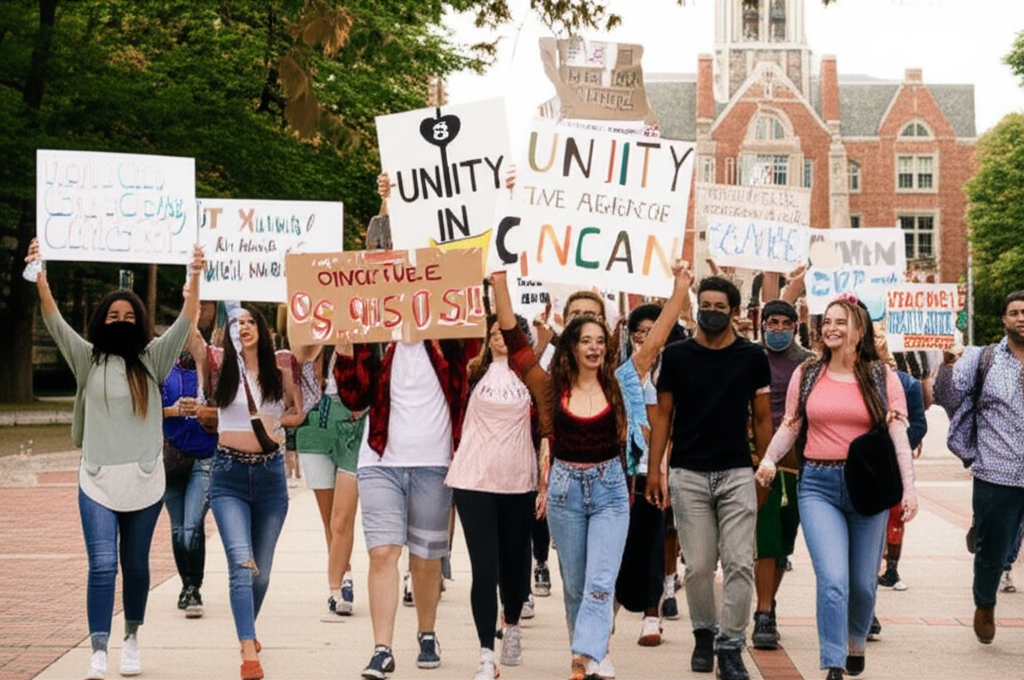Editorial Note
This article examines issues of academic freedom and student expression rights. We present multiple perspectives on this controversial topic while maintaining journalistic objectivity.
The Decision
Midwest State University announced the dissolution of Students for Reproductive Choice, a registered student organization that advocated for abortion access and reproductive healthcare, effective immediately following the spring semester.
Political Pressure Campaign
The decision came after a sustained pressure campaign from state legislators and conservative donors who threatened to withdraw funding from the university if the organization continued to operate on campus.
Sources of Pressure
- **State legislators:** Threatened $15M budget reduction for university
- **Major donors:** Three alumni pledged to end $2M annual giving
- **Board members:** Two regents called for organization's removal
- **Community groups:** Local organizations organized petition campaign
- **Media attention:** Conservative outlets highlighted organization's activities
"Taxpayer dollars should not support organizations that promote activities contrary to the values of our state's citizens. This university needs to remember who funds their operations."
— State Representative John Mitchell, Chair of Higher Education Committee
The Student Organization
Students for Reproductive Choice was founded in 2019 and had grown to 150 active members. The organization provided educational programming, advocacy training, and support for students seeking reproductive healthcare.
Organization Activities and Impact
| Activity Type | Frequency | Participation | Controversy Level |
|---|---|---|---|
| Educational workshops | Monthly | 50-75 students | Low |
| Guest speaker events | Quarterly | 100-200 students | Medium |
| Advocacy training | Semester | 25-40 students | High |
| Healthcare resource fairs | Annual | 300+ students | Medium |
| Political action campaigns | As needed | 75-100 students | Very High |
Range of activities conducted by the dissolved organization
University's Justification
University officials cited concerns about maintaining institutional neutrality and avoiding political controversy as primary reasons for the decision.
Official Statement
The university stated: 'While we support student expression, we must balance this with our responsibility to serve all students and maintain the support of our stakeholders and the broader community.'
Student Response
Members of the dissolved organization and other student groups have organized protests and are considering legal action to challenge the university's decision.
"This is a clear violation of our First Amendment rights and academic freedom. The university is caving to political pressure and abandoning its educational mission."
— Jessica Rodriguez, Former President of Students for Reproductive Choice
Legal and Constitutional Issues
Legal experts are divided on whether the university's action violates First Amendment protections for student expression at public institutions.
Legal Perspectives on University Action
| Legal Viewpoint | Key Argument | Precedent Cited | Likelihood of Success |
|---|---|---|---|
| Violation of rights | Viewpoint discrimination at public university | Healy v. James (1972) | Moderate to High |
| University authority | Institutional autonomy over student organizations | Christian Legal Society v. Martinez (2010) | Moderate |
| Political neutrality | Public institutions must remain politically neutral | Rust v. Sullivan (1991) | Low to Moderate |
Competing legal theories regarding the university's action
Academic Freedom Concerns
Faculty and academic freedom organizations have expressed concern that the decision sets a dangerous precedent for limiting controversial speech and organizations on campus.
Academic Freedom Implications
- **Chilling effect:** Other controversial organizations may self-censor
- **Faculty concerns:** Professors worry about research and teaching restrictions
- **Curriculum impact:** Potential pressure to avoid controversial topics
- **Recruitment challenges:** Difficulty attracting diverse faculty and students
- **Accreditation risks:** Potential conflicts with academic freedom standards
National Context
The incident reflects broader national tensions over reproductive rights and political expression on college campuses following recent Supreme Court decisions.
National Trend
At least 12 universities in conservative states have faced similar pressure to limit or eliminate student organizations focused on reproductive rights since 2022.
Comparative Responses
Other universities facing similar pressure have responded differently, with some maintaining support for student organizations despite political costs.
University Responses to Similar Pressure
| University | Pressure Type | Response | Outcome |
|---|---|---|---|
| State University A | Legislative threats | Maintained organization | Budget reduced 5% |
| Public College B | Donor pressure | Disbanded organization | Maintained funding |
| State University C | Board pressure | Compromise solution | Limited activities |
| Regional University D | Community pressure | Defended student rights | Ongoing controversy |
Varied institutional responses to political pressure
"Universities must balance competing interests, but when we allow external political pressure to dictate campus life, we undermine the very purpose of higher education as a marketplace of ideas."
— Dr. Robert Chen, President of the American Association of University Professors
Student Perspectives
Campus opinion on the decision is sharply divided, reflecting broader societal divisions on reproductive rights issues.
Student Reactions
- **Pro-choice students:** Organizing protests and petition campaigns
- **Pro-life students:** Supporting university decision as appropriate neutrality
- **Student government:** Passed resolution condemning university action
- **Graduate students:** Faculty senate representatives expressing academic freedom concerns
- **Uninvolved students:** Many expressing concern about precedent regardless of issue
Funding Implications
The university's decision highlights the complex relationship between public institutions, government funding, and donor influence.
Financial Context
Midwest State University receives 38% of its operating budget from state appropriations, with another 15% coming from private donations and endowment income.
Future Implications
The case raises important questions about institutional autonomy, academic freedom, and the influence of external stakeholders on university policies and student life.
Key Questions for Higher Education
- How should public universities balance political pressures with educational mission?
- What limits should exist on donor influence over campus policies?
- How can institutions protect both academic freedom and community relationships?
- What legal protections exist for student organizations on controversial issues?
- How will political polarization continue to affect campus expression?
As the controversy continues to unfold, higher education leaders nationwide are watching closely, recognizing that similar challenges may soon arrive on their own campuses.
